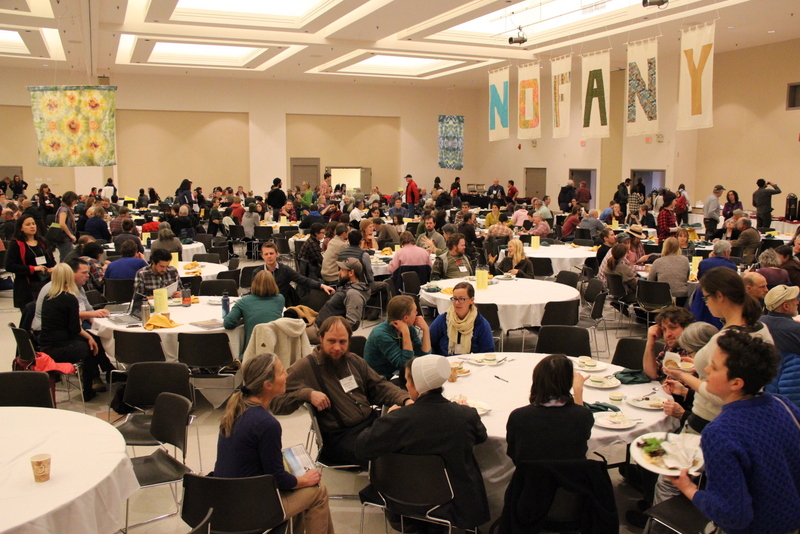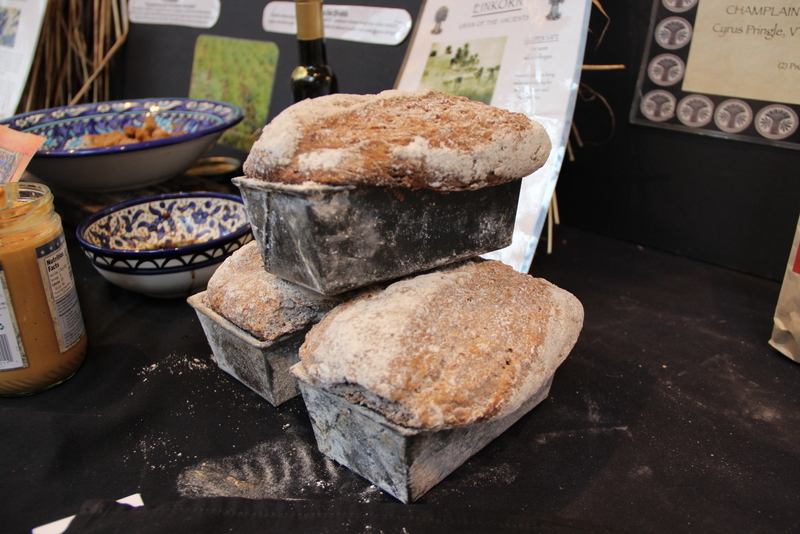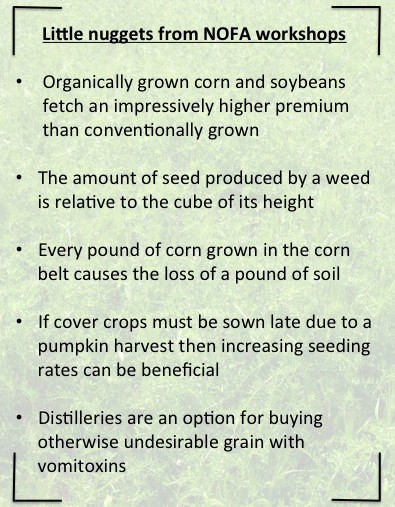By Sandra Wayman, Research Technician
“We’re kind of sexy right now; farmers are in!” the Commissioner Richard Ball stated in his opening to the keynote speech at the NOFA-NY 2015 conference. A large and enthusiastic group of growers, researchers, extension educators, and vendors gathered for the conference January 22-25 in Saratoga Springs, NY. Workshop topics ranged from urban mushroom cultivation to raising sheep.

Diversity was a theme throughout the conference. Klaas and Mary-Howell Martens, veteran organic grain farmers in Penn Yan, NY and recipients of the Farmer of the Year Award, lamented the loss of diversity of crop varieties. “We’ve traded excellence and diversity for uniformity,” Klaas said. He continued that a wide variety of grains used to be available on the market, offering an arresting assortment for different tastes. But the industry demands economies of scale, efficiency, and ease of processing. Now we have relatively few varieties from which to choose.
Graduate student in our sustainable cropping systems lab, Jeff Liebert, conducted on-farm research on Klaas Martens’ farm last summer looking at roll-down cover crops for soybean production. Klaas has been an enthusiastic participant in research at Cornell and we were pleased to see him receive the Farmer of the Year Award.
The Martens discussed the benefits from increased diversity in their system: introducing plow-down red clover into rotations provided more food for earthworms, for example. Klaas described using diversity as a fix for problems on the farm. Adding another crop into rotation, for instance, or intercropping could help reset a balance or stabilize the system. The Martens also discussed how improving soil health not only feeds the soil and reduces reliance on fertilizers, but also improves protein allotment and grain taste.

Two other themes, reducing fertilizer application rates and the importance of soil testing, appeared in both Brian Caldwell’s (Cornell Sustainable Cropping Systems Lab) and Vern Grubinger’s (UVM extension) workshops. Brian Caldwell made a case for reducing fertilizer use, citing the phosphorus load in our waterways and how reducing fertilizer rates actually may not decrease crop yield but will decrease weed pressure. He offered an insight into how the farmer-extension educator dialogue may influence fertilizer recommendations. For instance, extension educators want to avoid being accused of prescribing too little nutrition, resulting in crop failure, so they may slightly over-prescribe. Additionally, farmers may then apply extra fertilizer “just in case.” Thus agricultural systems are generally over-fertilized, contributing to problems like run-off and enhanced weed growth. Vern emphasized the importance of testing soil in specific fields rather than aggregating samples into one for the farm, which fails to represent distinctions among fields.
 The talks I attended focused mainly on grains or soil fertility, as I was a roving ear for our Sustainable Cropping Systems Lab. I learned about the importance of grain post-harvest handling with Klaas and Mary Howell Martens. Jack Lazor (Butterworks Farm), in his presentation on organic grain cropping, shared the unique perspective that “weeds are there to solve problems for you…”. Weeds can serve as indicators, for instance common lambsquarters grows in compost and indicates a high-N environment.
The talks I attended focused mainly on grains or soil fertility, as I was a roving ear for our Sustainable Cropping Systems Lab. I learned about the importance of grain post-harvest handling with Klaas and Mary Howell Martens. Jack Lazor (Butterworks Farm), in his presentation on organic grain cropping, shared the unique perspective that “weeds are there to solve problems for you…”. Weeds can serve as indicators, for instance common lambsquarters grows in compost and indicates a high-N environment.
Wes Jackson, the keynote speaker from the Land Institute, discussed perennial grains and the Land Institute’s work on Kernza, their name for intermediate wheatgrass (Thinopyrum intermedium), which is the first perennial grain with prospect. “We are grass seed eaters primarily”, he said as he described how a system of perennial grains could reduce soil erosion, reduce fuel and labor, and be a tremendous step towards improving our food system sustainability. He showed a life-size print of a Kernza plant—18 feet long—to illustrate the fortitude of the roots compared with an annual wheat plant. He ended his speech hopefully, that there is “an increase in the eyes to acres ratio”, that more people than ever before care about watchfully managing our land.

Our Sustainable Cropping Systems Lab is excited to be joining in preliminary Kernza research. We have planted a field of Kernza at our Musgrave research site and this coming year will be our first season of data collection.
Mary Howell Martens summed up the hope in our current chapter of sustainable agriculture by describing how we are in a time of novel ideas and creative problem solving. Research has taken us where management can be more refined and there are many new ideas and methods. “We shouldn’t worry about getting a piece of the pie,” she said, “the world is a kitchen and we can all bake our own pies!”













